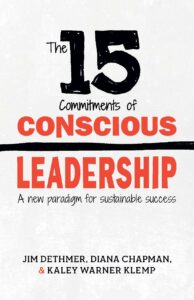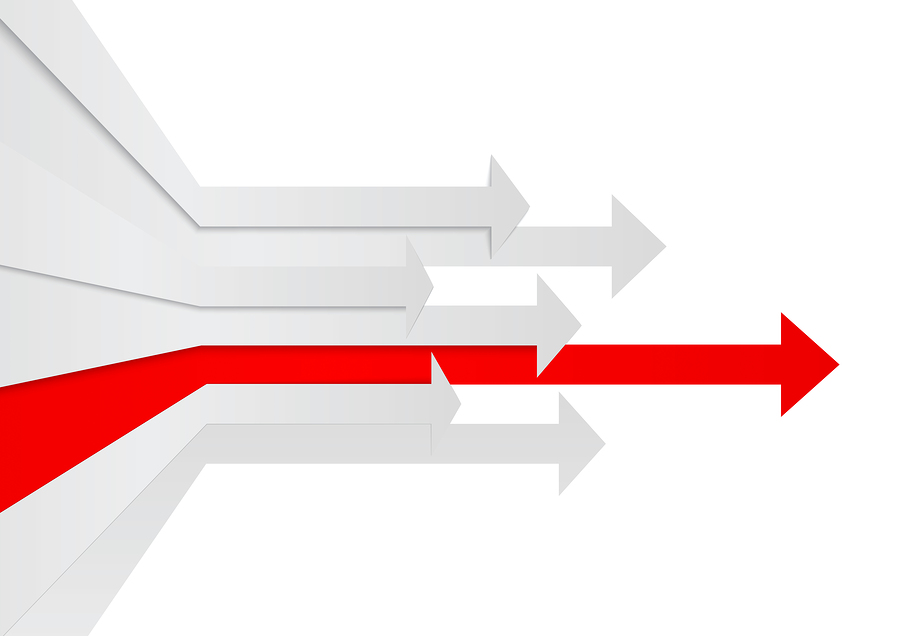Conscious Leadership
Jim Dethmer, Diana Chapman and Kaley Warner Klemp have just released The 15 Commitments of Conscious Leadership. It’s a practical leadership guide designed to help leaders become more conscious, take personal responsibility, and lead others in a win-win model.
If you need to pause, reflect more, and change your leadership style or behavior, this book will jumpstart your thinking.
Are You Above or Below the Line?
Personal responsibility and personal accountability are vitally important to success in any endeavor. You start the book with a simple but powerful model: Above the Line / Below the Line. Would you share that model with us?
The model is a simple black line. At any moment a leader is either above the line or below the line. When we are above the line, we are open, curious and committed to learning. When we’re below the line, we’re closed, defensive and committed to being right. What we suggest is that the first fundamental building block of conscious leadership is the ability to accurately locate yourself at any moment, asking, “Am I above or below the line?”
This sounds rather simple, but it actually requires a high degree of self-awareness. Many leaders spend most of their time below the line. In fact, it is the normal state. Asking them if they’re below the line would be like asking a fish if it’s wet. When leaders begin the journey to conscious leadership, they develop a greater and greater capacity to locate themselves accurately in any given moment.
Many leaders spend most of their time below the line because we go there when we are threatened or when we are in a fight or flight reactivity and the goal is survival. Our brains are hardwired to do this. This is normal. It is human. The issue is that this reactive pattern occurs whether the threat is real or perceived, and when the perceived threat is to the survival of the ego, we go below the line to protect it. Many ego-driven leaders experience a fairly constant threat to their ego. Thus they live and lead from below the line.
When leaders are below the line, they are in a low-learning state and create cultures of fear and threat. This results in lower creativity, innovation, collaboration and connection. When they’re above the line, they are in a state of trust, and the result is a higher level of effectiveness.
So the first key of conscious leaders is to accurately locate themselves either above or below the line. If they’re below the line, the second key to conscious leadership is to shift back above the line. Leaders master reliable shift moves that take them back above the line.
The Dangers of Right
I have also written about the dangers of always being “right.” Why do so many of us have a strong desire to be right at all costs?
The reason we are so committed to being right at all costs and to proving that we are right is that the ego doesn’t believe it can survive unless it is right. Being wrong is ego death. Being right, and more importantly being seen as being right, becomes our highest goal.
What we see is that conscious leaders become more interested in learning than in proving to everyone, including themselves, that they are right. The more secure leaders are, the less they need to spend time explaining, justifying, defending and proving their rightness and the more time they spend learning through deep listening, curiosity and wonder. As leaders learn to lead more from curiosity and wonder, they discover that breakthrough ideas come their way regularly. Also, the more leaders get deeply interested in learning over being right, the more their teams and organizations do the same.
The Drama Triangle
Would you share the “victim-villain-hero” triangle?
When we’re below the line, we’re in drama. All drama is driven by three roles: the victim, villain and hero.
VICTIM
When I’m a victim, I’m living as though I’m “the effect of” people, circumstances and conditions. I locate the cause of my experience as something or someone outside of me. I’m upset because a supplier didn’t deliver or the markets are down or there is bad traffic. It could also be that I’m happy, but the cause of my happiness is the circumstances outside of me. Victims never take full responsibility for their lives.
VILLAIN
Villains blame. They blame others, the collective and themselves. They move through life finding fault. Villains believe something is wrong and their goal is to figure out who caused it.
HERO
Heroes seek temporary relief. The key word is temporary. They don’t want to bring ultimate resolution to an issue because if they did, they would be out of a job. Heroes over-function and often take more responsibility than is theirs. They do this at the expense of others, the team and themselves.
Every time there is drama in an organization, or in our homes, the drama triangle is at play. We teach leaders to see this and to actually learn to consciously play on the drama triangle. The goal is not to try to get rid of the drama triangle but to move through the triangle into conscious leadership.
What questions should a leader ask to break this unhealthy dynamic?
 First, leaders should understand the benefits of being in the drama triangle so that they can see why they, and others, choose it.
First, leaders should understand the benefits of being in the drama triangle so that they can see why they, and others, choose it.
The first benefit of being in the triangle is that I get to be right. Everyone in the triangle is “right” and, as we said above, the ego needs to be right. Second, adrenaline is the chemical that drives the triangle, and people love to be amped up on adrenaline. They feel alive, engaged and ready. Third, being in the triangle with other people provides a form of connection. You can see this in families who really don’t know how to connect with each other apart from being in the triangle. Fourth, the drama triangle is entertaining. Almost all popular media and entertainment is built on the interplay of the victim, villain and hero. Finally, stuff gets done from the drama triangle. We would argue that what gets done from the triangle is exhausting, short term and not sustainable, but some things get done.
Understanding this allows a leader to have empathy for why they, and others, are in the triangle.
When we are above the line, the victim moves to the creator, the villain moves to the challenger and the hero becomes the coach. Creator, coach, and challenger are the new paradigm of high performing teams.
Here are questions to ask to shift from victim, villain and hero to creator, coach and challenger.
- Am I willing to shift? This is the most important question. About 80% of the time we find that leaders and teams, even when they know they are in the triangle, are unwilling to shift. Willing to shift is not the same as wanting to shift. Most people want to lose 10 lbs. Few people are willing to lose 10 lbs. Ask yourself this question first and answer truthfully.
- How am I creating this drama? Leaders must begin to shift the drama triangle with them. If there is drama around them, they are in some way responsible for it. How are they creating the drama or keeping it going?
- Am I willing to let go of being right?
- Am I willing to tell the unarguable truth? Where there is drama, there is a lack of conscious candor. Something authentic is being withheld.
- Am I willing to let go of seeing this issue or situation as so serious? This is a hard one for most leaders because to them it really is serious. But, as long as I see “it” as serious, I’m below the line and in drama.
Time to Play
You talk about the importance of rest and even suggest a “play break.” Why is this important?
We’ve all heard since we were kids, “All work and no play makes Jack a dull boy and Jane a dull girl.” We all know this yet we believe we must keep going at the pace we’re already going if we’re ever going to keep up. Dullness is epidemic, so is workaholism.
What we see in conscious leaders is that they learn that energy management is the real key to long-term sustainable success.
 One key to energy management is what Tony Schwartz calls “sprint and recovery.” We love this idea. Great leaders learn to sprint, e.g. live with focus, intention, passion, and direction, and then recover. Great leaders know what their personal sprint-and-recovery rhythm is on an hourly, daily, weekly, monthly, annual and decadal time frame. Mastering this leads to a significant long-term energy increase.
One key to energy management is what Tony Schwartz calls “sprint and recovery.” We love this idea. Great leaders learn to sprint, e.g. live with focus, intention, passion, and direction, and then recover. Great leaders know what their personal sprint-and-recovery rhythm is on an hourly, daily, weekly, monthly, annual and decadal time frame. Mastering this leads to a significant long-term energy increase.
Another key to energy management is introducing play into our lives. In fact, the greatest leaders actually live all of life as play. P lay is not silly, frivolousness or having a foosball table in your common area. Play requires not taking ourselves, others or situations too seriously.
To do this we must not make things mean more than they do. Children, our great teachers about play, get this. They get that soccer for six year olds is play. It’s not a referendum on athletic genius or a predictor of college admissions or a proof of parenting genius. It’s just play. Parents, on the other hand, don’t get this. They think it’s serious, and it means something.
The more leaders can live life as play, the more creative, passionate, innovative and collaborative they become. They also have fun and create work environments with incredibly high engagement.
Resisting Change
Why do we resist change?
We resist change because all of us are control freaks. Change threatens our internal sense of control. Often leaders tell us, “I don’t resist change. I like change.” What we discover is that they like change that they’re in control of. We also discover that some leaders are wired to like newness and variety, and the change they’re resisting is the change of consistency and predictability.
Humans have three great wants or desires. They want approval, control and security. These are universal. Most people believe that these things come from the outside. Approval comes from people liking and valuing me. Security comes from my net worth. Control comes from getting people and things to go the way I want them to go. What we see is that as long as I believe that these things come from the outside, change poses a threat to me getting them.
Another reason people resist change is they fear stepping into the unknown. Whenever we embrace change, we step into the unknown. Fear comes up. We coach leaders to see that to overcome the natural resistance to change, they must either have a large vision or significant pain. No one changes without one or both of these, but most leaders don’t spend enough time developing an inspiring transpersonal vision, and they spend too much time anesthetizing themselves from their pain. The result is little change.
Assess Your Own Willingness to Change
Would you share a few of the questions you developed to determine the willingness to change?
Willingness to change, especially to shift from below the line to above the line, is really the most important thing a leader can do. To do this, we have created a set of radical questions to support leaders in seeing if they are really willing to change. These questions include:
- Are you willing to take 100% responsibility (not more or less than 100%) for this issue? Are you willing to stop blaming and criticizing others and yourself?
- Are you willing to let go of being right? Are you willing to get more interested in learning than defending your ego?
- Are you willing to feel all of your authentic feelings (fear, anger, sadness, joy, sexual feelings)?
- Are you willing to stop all gossip about this issue? Are you willing to clear up all past issues with all relevant parties?
- Are you willing to shift from entitlement to appreciation about this issue? Are you willing to place your attention on how this issue is here for your learning? Are you willing to let go of all past resentment and replace it with genuine appreciation?
- Are you willing to let go of any ways this issue is coming from living in your zones of incompetence, competence or excellence? Are you willing to live only in your genius?
- Are you willing to let go of taking this issue seriously? Are you willing to treat this issue lightly and to play with it? Are you willing to have this issue resolve smoothly and effortlessly? Are you willing to honor your rhythms of rest and renewal and sprint and recovery around this issue?

